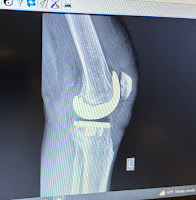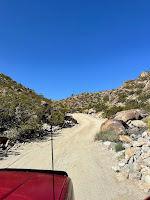 |
| Subcondral Insufficiency Fracture |
 |
| Townsend Rebel Reliver |
BORREGO STATE PARK: Once I was committed to the surgery, I started to go the gym 2 times a week and work with my trainer Randy Neuberg once a week. Wanted to go in strong---and it helped somewhat. The only problem, Loraine and I decided go on one last adventure, so we went out for a wild off-roading trip to the desert in Big Red- 2 weeks before the surgery. Turns out, bad idea, lots of flowers blooming this year, and we kicked up lots of dust spinning through the Collins pass.
 |
| BigHorn Sheep on Palm Canyon Trail. |
 |
| Side view |
 |
| Front view |
 |
| Ossur "Cold Rush" ice machine-awesome |
 |
| Iced bottles |
 |
| First day home from surgery |
 |
| Blood spot |
So we drove home and the fun began. I came in the house with my walker and proceed to say, " that didn't hurt at all! what was the big deal I can already walk" so off I went around the house and over to the neighbors. Big Tip-- don't do it! Still no pain the rest of the day and the morning of the next day. And then Whammy!! The nerve block and Anesthesia wore off at about 12pm and I had not taken my meds--- If felt like somebody had smacked me with a sledge hammer in the knee and my knee and leg had swelled up almost doubling in size. They already had another compression sock on my surgical leg.. thank goodness. The next 4 days was a blur, tried to do my exercises (leg slides, and quad contractions) it started bleeding. But that's the exercises they want you to do, so I suggest to do them, just don't overdo --Keep the compression socks on your surgery leg as many days as you can because as soon as you take it off the swelling begins.
 |
| straight leg cast. |
I used Manuka Honey to help the wound. This is great stuff for wounds and burns, Manuka Honey UMF 20+ and Mgo 850 (Costco -on sale was $79.) Make sure you check with the doctor first to see if they approve it. There's a lot research which talks about its benefit starting with WebMd-Web MD Manuka honey
MEDS: We all hate to take Oxytocin (Percocet), because of the possible stoppage of the digestives system. But seriously, you just take the stool softener with it everytime and there shouldn't be a problem. It takes the edge off and certainly helps your sleeping. Make sure you ice all the time, especially before you go to bed. And I took Celebrex for inflammation (it is also a blood thinner) and a blood thinning Baby Aspirin-80 mg for 1 month afterwards. Actually, I still take the 200 mg Celebrex even now after almost 7 weeks. A hospital type bed is a good idea (but don't you need one), sure helps for getting up and down and elevating your leg. I am sure you could rent one from a medical supply company. And if you can stay down stairs, even better. We had previously purchased a Tempur-pedic mattress bed from Costco, it is great and is remotely controlled.
A really good vitamin supplement is Ester-C, a gentle non-acidic supplement. You can get it at Sprouts or on line. It is recommended by some orthopedic surgeons, take 1000mg every day to speed up healing for the tissues.
Highlight: Swelling goes way down in about 7-10 days. I used the walker and then briefly a cane, but was completely off of both after 10 days. Still keep icing using the ice machine off and on all day. I also used a gel ice pack on top and under the knee joint as an alternative when I was watching TV in the other room. You can get a gel pack on Amazon or any drug store. Sleeping on the other hand has taken 6 weeks where I can go to sleep comfortably, using a pillow between my legs and sleeping on my side. If I have any pain for my knee or back I use these Salonpas patches (have methyl salicylate aspirin, (aspirin) to take off the edge. i get them at Costco 140 pack for about $20.
Physical Therapy: (PT) From now on is the major source of pain for the next couple months. I had a wonderful PT person, Pam Cloud, at Core Orthopedics. And she worked me hard each time. Big suggestion- I signed up for the Laser low light, pre treatment before each appointment. Looks like a ultrasound machine, and does wonders for soft tissue. A 10 treatment packet was $400 and well worth it, made PT a lot more productive. After each PT, I was pretty exhausted, and it usually went into the next day. They will work on tightness and strengthening. Your knee will continue to be tight for several months. Their first job, and yours is to get your whole leg (especially at the knee joint) to 0 degrees extended straight, and at least 115-120 degrees bent, so you can ride a bike etc. Once I got on the stationary bike it really helped on the tightness. So I always try to do this at home on my bike or the gym, or elliptical and then do any exercises.
 |
| Side view, you keep the patella (knee cap) |
The Hypervolt ( I call it the pounder) is an invaluable tool for moving fluids around the muscles above the knee joint and below. In both of these areas, swelling appears often after any physical exercise, so instead or with ice I use it to loosen things above. Make sure you use the flat head. Now days they have cheaper ones on Amazon.
 |
It has taking me 6 weeks to start to feel normal. I can walk 1 mile, use the stationary bike for 10-15 minutes, and I started going to the gym for some upper body work and to use the leg lift and leg extension machine (on your back or leaning back). These are 2 excellent machines for strengthening the Quad, and your overall leg strength. Plus I love using the Swiss ball for wall slides and to do some core work for my stomach and back muscles. It will took me about 7 weeks before I could go in a community pool. (after the scab falls off). Scarring: It changes over time, thank goodness, it was a pretty gnarly scar at the beginning. Remember they stitch the muscles together below the skin and use a glue on top. Takes awhile for it to peel off. Luckily you can take a shower after 3 days. You may want to try Silicone Scar Patches which reduce the scarring and you can get from any pharmacy or online, I bought the roll so I could roll it over the scar. Loraine used it on her hip replacement scar and you can barely see it now. Silicon roll scar sheets |
 |
| 3 days after surgery |
 |
| 6 weeks after surgery-scar sheets are amazing and cheap get the roll. |
9 weeks: Getting ready for a huge hiking trip to Canada at the end of July. Using a hiking poles is a must.... probably won't hike over 2 or 3 miles, I will be almost 3 months out by then. It will take me about 7 weeks before I can go in a community pool. (after the scab falls off). *Post note-- I did 5 miles up Mt. Baker in Washington--no problem--but i used hiking poles
Would I do it again: Absolutely, just be ready for the recovery- PT is a challenge 2x a week.
** double post note.. 2 years out now, I can ski, surf, bike, dance you name it, but it still feels tight at times, you still have your patella tendon because they kept my Patella (knee cap) ask your doc about that.
*** post note, after talking to Orthopedic
Make sure along the way to ice and elevate if you do too much, swelling and tightness is just part of it. By icing you will feel better the next day. Just remember you don't what the outside of your joint to keep swelling. Good luck-- if you have any questions feel free to email me --Jerry T.





No comments:
Post a Comment